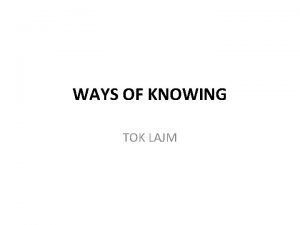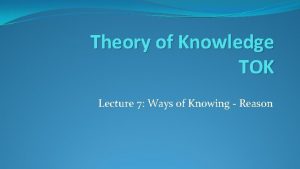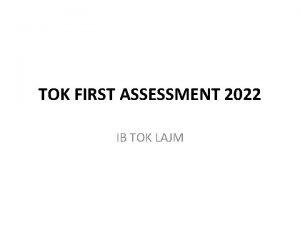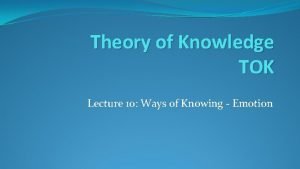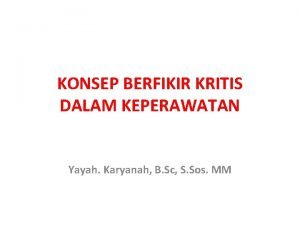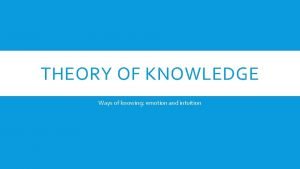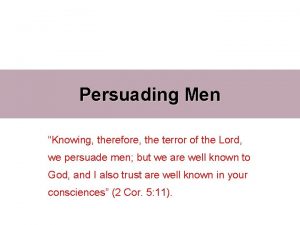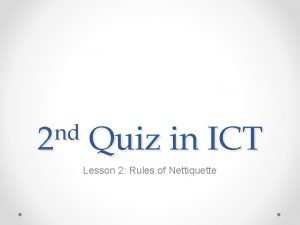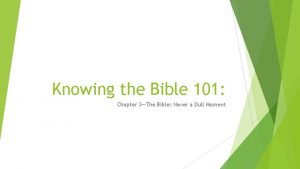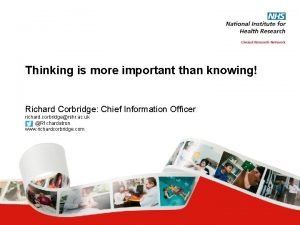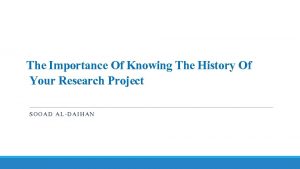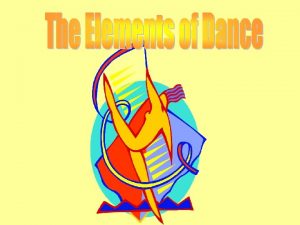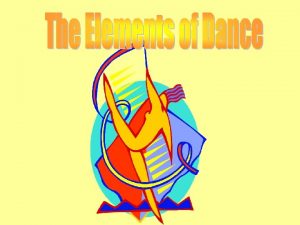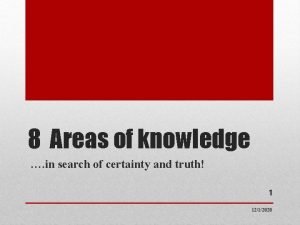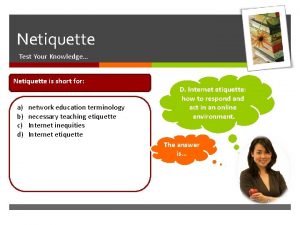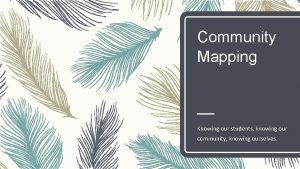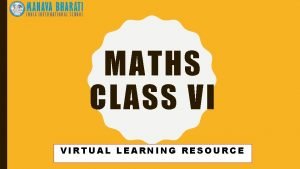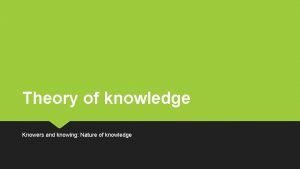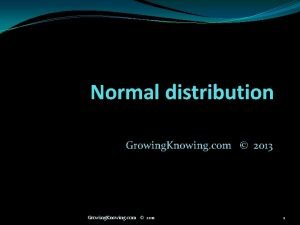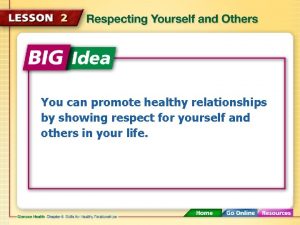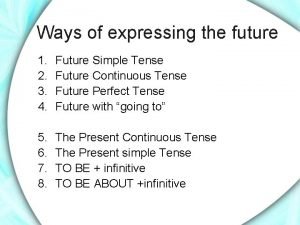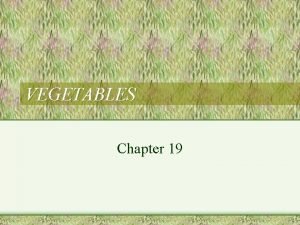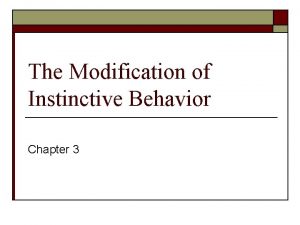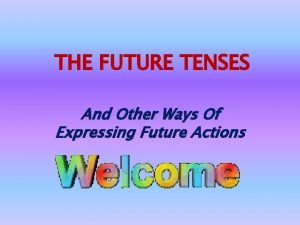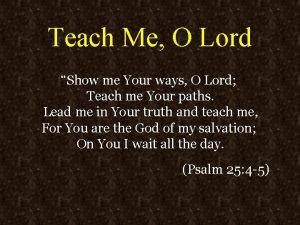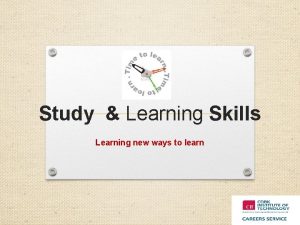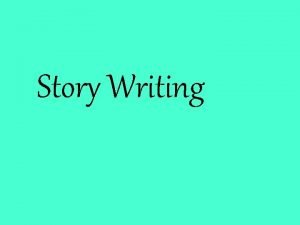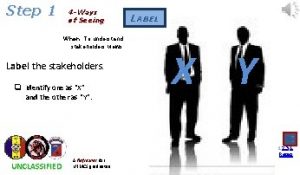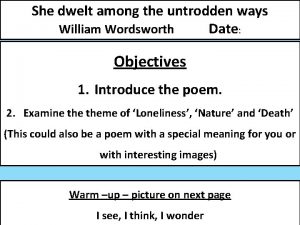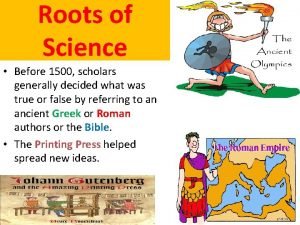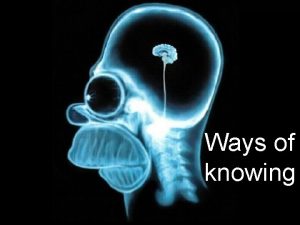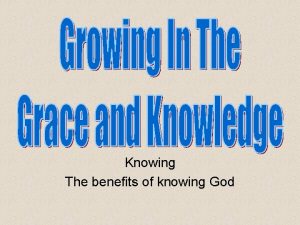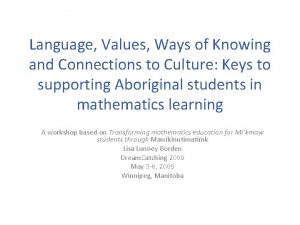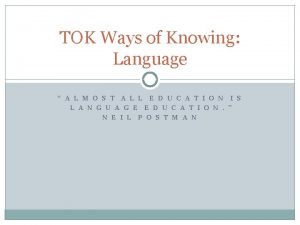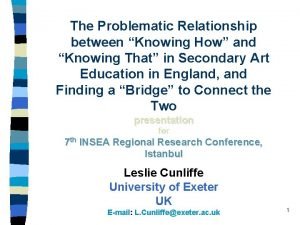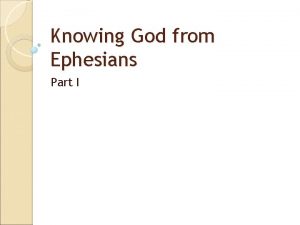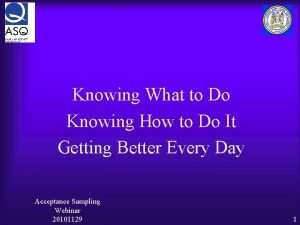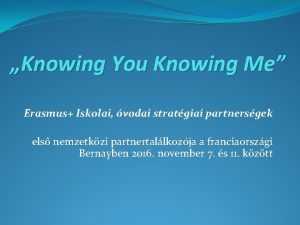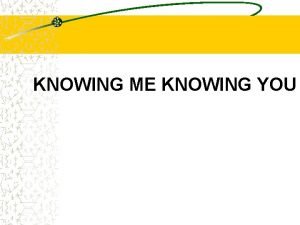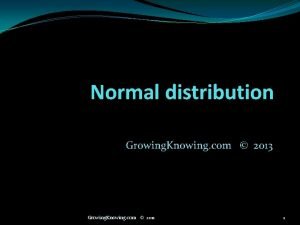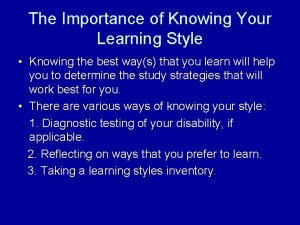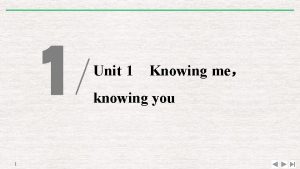Language Ways of Knowing f o y a























































- Slides: 55

Language Ways of Knowing

f o y a W a s a e g a u g n a L “ e g a p Title new Knowing Journal Think of a single day in your life. How, during it, do you use language? Think of all the different roles that language plays in your life during a typical day.

? e g a u g n a l n r How do we lea ★ Language is part of our human heritage, passed down from parent to children and developed to take its particular form from the speech communities where we live. ★ B. F. Skinner and Noam Chomsky both have contributed to our shared knowledge of how we learn language, but their theories contrast.

? e g a u g n a l n r How do we lea Skinner (1957): ★There is no innate (born with, natural) capacity for language. ★Language is learned from experience, like a behavior. ★We imitate, practice, correct.

? e g a u g n a l n r How do we lea Chomsky (1972): ★ The capacity for learning is innate in humans (already present from birth as a feature of the human brain). ★ We absorb grammatical patterns and generate new language constructions we have never heard. ★ We learn language without being formally taught and corrected.

g n i l l e T r o g n i w Activity 1: Sho 1. On a sheet of paper draw a series of lines to make a fairly simple geometrical figure (this usually works with 8 -12 lines). 2. Your task will be to describe your figure to your partner so he or she can reproduce it exactly. 3. Sit back to back on chairs or on the floor so that neither of you can see the other’s drawing. One rule: no turning around, stretching of necks, or outright peeking is permitted! Clue: you might want to say things like “fold your paper in half”, “divide your paper into quadrants” and the like.

s n o i t s e u Q n o i t c e l f e R : 1 y t i v i t Ac ★ Did you find it difficult not to show rather than tell? ★ In what situations is knowledge best communicated by demonstration rather than language? ★ To what extent is the drawing task made easier by shared vocabulary regarding lengths, angles and standard shapes? ★ In what ways are your conclusions relevant to the communication of knowledge in all areas (history, English, math, science, etc)?

n o i t s e u Q e g d e Journal Knowl What does the word innate mean? To what extent is our capacity to learn language innate? Can you think of any examples?

Body language http: //www. ted. com/talks/amy_cuddy_your_body_language_shapes_who_you_are (20 min) TED Talk Reflection: Copy and respond to the following quote; consider how the TED Talk ties in with the quote. “Who does not know another language does not know his own. ” -Goethe, 1749 -1832

Journal “Man is the animal that speaks. Understanding language is thus the key to understanding man. ” (Thomas Szasz, 1920 -2012) To what extent is the human species distinct in having language?

? s n a m u h o t e v i s u l c x e e g a u g n a Is l Animals communicate with each other, often extensively. Can you think of any specific examples?

? s n a m u h o t e v i s u l c x e e g a u g n a Is l ★Though animals do communicate, it is not the same as human language. ★Most animal communication is instinctive and limited, not abstract or symbolic. It is grounded in the biological characteristics of the species. Can you think of any exceptions?

Journal 11/30 Brainstorm a list of symbols of communication that have meaning for you.

m e t s y s c i l o b m Language: a sy ★Symbolism is the use of one thing (an object, image, sound, word, etc. ) to stand for something else, with a connection between them that we create ourselves according to our own conventions.

x e l p m o c d n a s u o u g i b m a : m s i l Symbolism exists on spectrums of kind and complexity, which means we have to consider the following questions: ★ Does the thing we use as a symbol clearly represent one idea, or does it gather more ideas for us as we use it? ★ Does the symbol carry a universal meaning? Discuss and analyze a few of your symbols with your group. Be prepared to share one with the class.

? e g a u g n a l l a s r Emoji: a unive Read the two articles and discuss the following questions: ★ Is this language? Is this the WOK we discuss in TOK? ★ What are the essential features of human language? ★ To what extent could emoji be considered a type of universal language? ★ How do differences in languages affect the kind of knowledge we can communicate and exchange?

m Simple symbols, e t s y s c i l o b m y s e h t d n a , s l o b m y s x comple ★Read pages 134 -136, starting with “Signs: simple symbols” and ending before “Sign language and the deaf” ★Complete #1 in the orange box on p. 135

y t i u g i b m a : g n i n a e m f o s e d Sha �Consider the activity you just completed. What does ambiguous mean? How can language be ambiguous? Each of the following sentences is ambiguous. Give two different meanings for each: A. Flying planes can be dangerous. B. Bob tickled the man with a feather duster. C. As Imran came in to bowl I saw her duck.

s e i t i v i t c A r e n t Par 1. Work with a partner to use the words in the envelope to make meaningful sentences. (There are 2 different sentences. Each is its own color. ) a. Answer in your notes: Did you find it easy to put isolated words into an order that made sense? Why? Did you find more than one way to combine the words for meaning? 2. Complete the first part of Activity #2 in the orange box on p. 137. DO NOT continue on to p. 137 until instructed.

y r a n o i t c i P e n o Teleph Write a simple sentence of your choice! DO NOT LET ANYONE SEE IT! “The cow jumped over the moon” It can NOT make fun of another student. It can NOT be inappropriate or imply anything inappropriate.

y r a n o i t c i P e n o Teleph Pass your sentence to the right. The person who receives your sentence will fold it over the top and draw a picture to represent your picture. Pass the picture to the right. The person will fold over your picture and write a sentence based on what they see. Continue!

n o i t c e l f e R. c Tel. Pi What did the telephone pictionary activity demonstrate?

s t n i o P n o i t a p i Cans for Partic 2 points per can 5 cans = 10 points (or one day) Max = 25 cans (full week) If I win, I buy donuts for 2 nd and 4 th period

Journal What is the role of the dictionary? Is it descriptive, recording the changes in language as they happen? Or is it prescriptive, legislating what changes in language are acceptable?

s s e n e u g a v : g n i n a e m f o s e d Sha ★ Vagueness: meaning can depend on context, and even with context a word can be interpreted differently by different people (just like the picture we looked at. �Without thinking too much about it, write a figure for each of the following: a. John lives close to his school. How near does he live? b. Janet is a heavy smoker. How many cigarettes does she smoke a day? c. Mr. Smith is middle-aged. How old is he? d. Nafisha’s mother earns a lot of money. What is her annual income?

n o i t a t o n e d : g n i n a e m f o s e d Sha ★ Denotation is the core definitional meaning(s) of a word and thus is often connection with the dictionary.

n o i t a t o n n o C Denotation vs. What is the difference between denotation and connotation? Denotation – literal meaning of a word Connotation – associations connected with the word or emotional suggestions with the word Connatation for the word snake could be evil or danger

s g n i n a e m g n i t f i h s d n a s d r o w l Read the article “ 20 Words That Once Meant Something Very Different” and answer the questions at the end in your journal- be ready to discuss. http: //www. ted. com/talks/anne_curzan_what_makes_a_word_real (TED Talk 17 min)

Words Inmate – Used to mean roommate Heartburn – Jealousy or hatred Bully – Superb or wonderful Diaper – fabric with diamond shaped figures Artificial – Full of artistic or technical skill

n o i t c e l f e R k l TED Ta Respond to the following quote in your notes. Be sure to consider what we have read and watched today. “‘When I use a word, ’ Humpty Dumpty said in a rather scornful tone, ‘it means what I choose it to mean- neither more nor less. ’ ‘The question is, ’ said Alice, ‘whether you can make words mean so many different things. ’ ‘The question is, ’ said Humpty Dumpty, ‘which is to be masterthat’s all. ’” -Lewis Carroll, 1832 -98

Journal Get a book! What do the following mean? Mr. Klapper has a heart of gold. Carson is blind as a bat. Don’t judge a book by its cover.

Due this week CAS group names and 5 project ideas CAS Hours Log Sheet for end of October/November/1 st week December (2 -4 hours per week) CAS Hours into managebac

r o h p a t e m : g n i n a e m f o s e d Sha ★ We tend to speak of one thing in relation to another. Life is a journey. ★ Metaphors tend to reveal that we think in certain ways and encourage us along certain pathways of thought. ★ We think in terms of the correspondences between a source and a target. ○ Time is money. (We save time, waste time, budget time. ) ○ Argument is war. (We win or lose arguments. )

r o h p a t e m : g n i n a e m f o s e d Sha “My brother is a butcher. ” �“My dentist is a butcher. ” (Which is a metaphor? What are the different connotations of each sentence? ) ★ Metaphors can change with time, but some metaphors have become so commonplace that it is difficult to determine whether they are literal or metaphorical. Examples: ‘chair leg, ’ ‘in love, ’ and ‘sharp tongue’- Can you think of others?

g n i n a e m f o s e d Sha ★ How we deal with the ambiguity of language - its imprecision in meaning, connotations, etc. - depends on the nature of our communication and the kind of knowledge we are exchanging. ★ In some fields, precision is crucial. In others, finding the right word may depend on deliberately using the ambiguity. Discuss: When might precision in language be crucial? When might we want to deliberately use ambiguity?

? e m a n i s ’ t a Wh ★Answer the p. 141 blue box “For Reflection” questions in your notes. ★Discuss your responses with your group and be prepared to share with the class. ★Girls would you marry a man named Horace or Barry? ★Boys would you marry a girl named Gretta or Dolores?


e g a u g n a l n i s e Perspectiv ★ We need to be critically aware of the influence of perspective on what is said and how it is expressed- by ourselves and others. Individual interpretations and perspectives shape communication. ★ Thus, any communication, whether in conversation, research, or newspapers demands some degree of interpretation.

e l p o e P e c n e u l f n I n a C e g a u g n 4 Ways La 1. Emotionally Laden…the connotations of different words are considered. 2. Weasel Words…words such as many, should, and probably Example: “Our product will work for you if you simply follow the directions carefully. ” 1. Our product can restore up to 25% of lost hair. 2. Dentifresh toothpaste helps fight tooth decay. 3. Grammar: passive vs. active voice A. Many villages were bombed. B. We bombed many villages. (The first sounds like a natural disaster, the second puts the spotlight on the perpetrators. )

e l p o e P e c n e u l f n I n a C e g a u g n 4 Ways La 4. Revealing and Concealing…language can be used not only to reveal certain aspects of reality, but also to conceal other aspects by diverting attention away from them. a. I have invited an attractive blonde to the party. b. I have invited a cellist to the party. c. I have invited a marathon runner to the party. d. I have invited a lesbian to the party. These can all be statements about the same person. The description we choose to use will affect the way other people see the person.

y t i v i t c A g n i t i Slanted Wr ★Complete the orange box discussion activity on p. 144. ★Be prepared to discuss the following questions: ○ Are “true” and “false” tidy categories? ○ What is the role of perspective in telling the truth?

e g a u g n a l n i s e v i t c e p s r e p l a r u t Cul ★In the 1930 s, Benjamin Lee Whorf lived with the Hopi and learned their language. His analysis between the Hopi and European languages led him to put forth the idea of “linguistic relativity”- that the particular language we speak leads us to think in significantly different ways about the world.

Discussion Discuss the blue box questions on p. 147 with your group. Be prepared to share with the class.

n o i t a l s n a r T d n Language a ★ It is commonly thought that there are over 3, 000 different languages. ○ What would be gained or lost if everyone spoke the same language? ★ Problems of Translation ○ Context (Inuit-snow, or gossip, talk, discuss, chat) ○ Untranslatable words: English word ‘quaint’ ○ Idioms-”barking up the wrong tree, ” “pulling your leg, ” and “let the cat out of the bag. ” ○ Lost in translation: Can it be retranslated back to its original language?

s n o i t s e u Q e g d Knowle ★To what extent do the cultural differences reflected and created by language influence our perspectives on the world? ★To what extent is it necessary to learn the language of a group to understand its perspective fully?

s e v i t c e p s r e p g Recognizin ★ It is important to recognize the perspectives used to shape communication by listening and reading critically, and considering the following aspects. 1. Selection of parts 2. Emphasis Context 4. Relationship 5. Framing in

Selection ★Out of all the possible events or details that could have been reported, what has been selected? ★Can you tell whether you are getting the whole picture or just a small slice? ★Whose voice is reported and whose is left out?

Emphasis ★Out of all the events and details reported, what has been stressed as most important, and what do the guiding values or criteria seem to be for this emphasis?

s e u l a v d n a n o i t Coloring: emo ★What connotations of emotions or values color the use of language? ★Do the word choice and expressions in description tell you more about the writer’s perspective or the thing(s) being described?

s t r a p f o p i h s n Relatio ★Are the parts of the account sequenced with an argument that is stated, with linear presentation, logical connections, and verbal transitions? Or are they presented as a juxtaposition of images placed together so that, in their association, the meaning is implied?

t x e t n o c n i g Framin ★ In what context has the account been placed and how is it identified with headlines and accompanying images? ★ How might the framing affect the overall meaning of the passage? What does its purpose seem to be? Ex) “Troops Abandon War-Gutted Iraq” creates a different effect from “Troops Arrive Home to Joyous Families, ” especially if the former is accompanied by images of destroyed buildings and the latter by hugging families.

s s e n t c e r r o C l Politica ★ Political Correctness is a movement which seeks to use language to change attitudes about the oppressed or disadvantaged. What are some examples of this? ★ What arguments are there in favor of political correctness and what arguments are there against it?

e l a t y r i a F t c e r Politically Cor Follow the guidelines on the handout to analyze a fairytale and retell it in a satirically politically-correct version.

Journal Copy and respond to one of the following quotes. 1. “I got a feeling about political correctness. I hate it. It causes us to lie silently instead of saying what we think. ” -Hal Holbrook 1. “Political correctness does not legislate tolerance; it only organizes hatred. ” -Jacques Barzun

. . . n o i s u l c n o In c ★ Read pages 146 -147, starting with “Language: roles in our lives” ★ Discuss the three knowledge questions in the “Overcoming limitations” section with your group and write a summary of your group’s response in your notes. Be prepared to share out with the class.
 Elpoe meaning
Elpoe meaning Ways of knowing language
Ways of knowing language The circle analysis
The circle analysis Not knowing is worse than knowing
Not knowing is worse than knowing Woks ib
Woks ib Way of knowing tok
Way of knowing tok Tok essay titles 2022
Tok essay titles 2022 Tok ways of knowing
Tok ways of knowing Romans 3:10
Romans 3:10 The gift of knowing you
The gift of knowing you 最美的祝福
最美的祝福 How did montresor know that the house would be empty?
How did montresor know that the house would be empty? Implementasi berpikir kritis dalam keperawatan
Implementasi berpikir kritis dalam keperawatan Faith is knowing the sun will rise
Faith is knowing the sun will rise Emotion as a way of knowing
Emotion as a way of knowing Knowing the terror of god we persuade
Knowing the terror of god we persuade A program designed to send your advertisements, pop-ups
A program designed to send your advertisements, pop-ups Knowing the bible 101
Knowing the bible 101 Knowing god personally
Knowing god personally Thinking is better than knowing
Thinking is better than knowing Importance of knowing the history
Importance of knowing the history Contoh konsep, nilai moral dan norma
Contoh konsep, nilai moral dan norma The area of space occupied by the dancer's body
The area of space occupied by the dancer's body Bound and free movements
Bound and free movements 8 areas of knowledge
8 areas of knowledge Knowing where you stand
Knowing where you stand Importance of knowing your learning style
Importance of knowing your learning style A flame is an online chain letter
A flame is an online chain letter Knowing more remembering more
Knowing more remembering more Knowing your rank
Knowing your rank Knowing my community
Knowing my community Knowing your future
Knowing your future Knowing your audience
Knowing your audience Growing knowing
Growing knowing Introduction of knowing our numbers
Introduction of knowing our numbers Nature of knowledge and knowing
Nature of knowledge and knowing Growingknowing
Growingknowing Ways to show respect to others
Ways to show respect to others Ways with words literatures in english
Ways with words literatures in english Expressing the future
Expressing the future It is higher in sodium and possibly mushy in texture
It is higher in sodium and possibly mushy in texture Ways to reduce poverty
Ways to reduce poverty Modification of instinct
Modification of instinct Ways of expressing future tense
Ways of expressing future tense Ways of expressing future tense
Ways of expressing future tense Assessing grammar effectively
Assessing grammar effectively Lord show me your way
Lord show me your way New ways to learn
New ways to learn Objective of story writing
Objective of story writing 4 ways of seeing
4 ways of seeing She dwelt among the untrodden ways poem
She dwelt among the untrodden ways poem Ways of enriching the bible understanding
Ways of enriching the bible understanding Biochemical sedimentary rocks
Biochemical sedimentary rocks Galileo definition
Galileo definition Draw rmmm plan
Draw rmmm plan Respect what is
Respect what is




